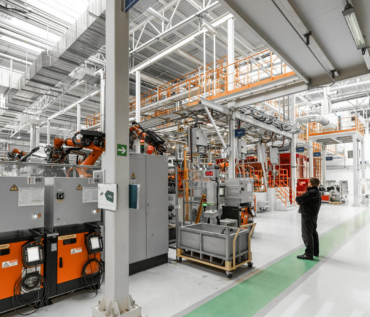In Adelaide’s competitive manufacturing landscape, one principle separates thriving operations from struggling facilities: healthy plant operations directly translate to healthy output. Smart plant managers understand this fundamental truth—equipment reliability isn’t just about avoiding breakdowns; it’s about optimizing every aspect of production efficiency.
The Direct Link Between Plant Health and Production Output
Your facility’s output quality, consistency, and volume are direct reflections of your equipment’s operational health. When machinery runs smoothly, production flows seamlessly. When equipment degrades, output suffers—not just in quantity, but in quality, delivery times, and ultimately, customer satisfaction.
At Gaja Engineering, we’ve observed that plants with structured maintenance programs consistently outperform reactive facilities by 40-60% in uptime and deliver more predictable output schedules.
What Defines a “Healthy Plant”?
A healthy industrial plant exhibits several measurable characteristics:
- Operational Reliability: Equipment performs consistently within designed parameters, with minimal unexpected failures or performance degradation.
- Predictable Maintenance Schedules: Planned maintenance occurs during scheduled downtimes, not emergency shutdowns that disrupt production commitments.
- Asset Longevity: Machinery and fabrication equipment operate well beyond minimum service life expectations, maximizing capital investment returns.
- Safety Compliance: All systems meet Australian safety standards, with properly functioning guards, emergency stops, and safety interlocks.
- Energy Efficiency: Well-maintained equipment consumes optimal energy levels, reducing operational costs and environmental impact.

The Hidden Costs of Unhealthy Plant Operations
Many Adelaide plant managers underestimate how equipment degradation affects their bottom line. An unhealthy plant operation creates cascading problems:
Quality Inconsistencies: Worn components produce parts outside tolerance specifications, increasing reject rates and rework requirements.
Production Delays: Unexpected breakdowns force schedule changes, missed delivery commitments, and customer dissatisfaction.
Increased Operating Costs: Emergency repairs cost 3-5 times more than planned maintenance, including premium parts pricing and overtime labour.
Safety Risks: Degraded equipment creates hazardous working conditions, increasing incident likelihood and potential WorkSafe SA compliance issues.
Reduced Asset Value: Poorly maintained equipment depreciates faster, reducing resale value and requiring premature replacement
Building a Culture of Plant Health
1. Implement Condition-Based Monitoring
Move beyond calendar-based maintenance. Use vibration analysis, thermal imaging, and oil sampling to detect wear before failure. Adelaide’s leading fabrication plants increasingly rely on data-driven systems to optimize servicing intervals.
2. Establish Maintenance Documentation Systems
Detailed maintenance logs create valuable insights. Document every inspection, repair, and component change to identify recurring faults and improve planning accuracy.
3. Invest in Skilled Maintenance Teams
Equipment health depends on skilled technicians who understand mechanical systems, welding integrity, and precision machining. Partnering with Gaja Engineering gives you access to specialized expertise for complex repairs and fabrication upgrades.
4. Prioritize Critical Equipment
Identify high-impact assets — bottleneck machines or single-point-of-failure systems — and give them top priority in your maintenance schedule.
5. Balance Production with Maintenance
Skipping maintenance to hit production targets may yield short-term output but leads to long-term reliability loss. Sustainable operations demand balance between throughput and asset care.
The ROI of Healthy Plant Operations
Investing in plant health delivers measurable returns:
- Reduced downtime: Planned maintenance causes 60-80% less production loss than emergency repairs
- Extended equipment life: Proper maintenance can double machinery service life
- Lower operating costs: Efficient equipment reduces energy consumption by 15-25%
- Improved output quality: Well-maintained machines produce consistent, in-specification products
Enhanced safety: Properly functioning equipment reduces workplace incidents.
Adelaide’s Maintenance Excellence Partner
For Adelaide’s manufacturing and fabrication sectors, maintaining plant health requires both strategy and execution. Gaja Engineering provides comprehensive industrial maintenance solutions—from precision machining and custom fabrication to equipment refurbishment and compliance upgrades.
Our local team understands the unique challenges facing South Australian manufacturers. We deliver practical, cost-effective maintenance strategies that keep your plant healthy and your output strong.
Don’t wait for equipment failure to impact your production. Smart plant managers know that investing in plant health today prevents costly output problems tomorrow.
Frequently Asked Questions (FAQ)
1. What defines a healthy plant operation in industrial manufacturing?
A healthy plant operation maintains consistent equipment reliability, predictable maintenance schedules, and strong safety compliance. It also optimizes energy efficiency and ensures machinery operates within design limits — all of which contribute to steady, high-quality output.
2. How can smart plant managers improve equipment reliability?
Smart plant managers adopt proactive maintenance strategies such as condition-based monitoring, vibration analysis, and thermal imaging. Partnering with specialists like Gaja Engineering ensures expert diagnostics, precision repairs, and improved operational uptime.
3. What is the impact of preventive maintenance on plant output?
Preventive maintenance reduces unexpected breakdowns, minimizes downtime, and maintains product quality. Well-maintained equipment enables smoother production flow, helping Adelaide fabrication facilities achieve consistent output and higher customer satisfaction.
4. How often should plant maintenance be performed?
Maintenance schedules depend on equipment type and production intensity. Critical assets may require weekly or monthly inspections, while complete overhauls are typically done quarterly or annually. Condition-based monitoring can fine-tune these intervals based on real-time data.
5. Why do many plants struggle with maintenance planning?
Common reasons include reactive maintenance culture, limited skilled technicians, lack of proper documentation, and production pressure overriding maintenance needs. Building a strong maintenance culture with systems support helps overcome these challenges.
6. How does Gaja Engineering help Adelaide’s plant managers maintain healthy operations?
Gaja Engineering provides full-spectrum maintenance solutions — including custom fabrication, precision machining, and equipment refurbishment. Our Adelaide-based team supports plant managers in improving reliability, extending equipment life, and ensuring compliance with Australian standards.




